How to cook barbecue pork ribs like an American pitmaster
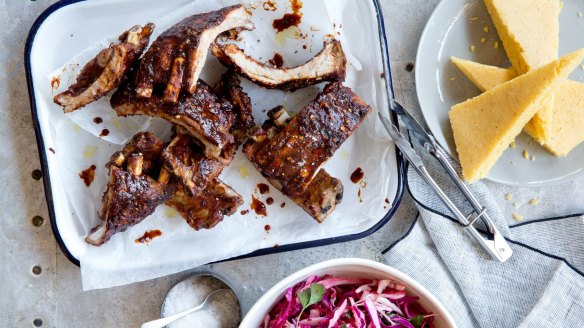
Simple as ribs may appear, there's an art to mastering them, as anyone from a weekend warrior to champion pitmaster can attest. "The reason they have all these festivals and barbecue cook-offs all around [America] – the reason for the fanfare – is that ribs are really quite detailed," says Curtis Stone, chef-owner of the Los Angeles restaurants Maude and Gwen, the latter of which includes an in-house butcher shop. "If you want to do it right, ribs take time. And skill." (See Stone's sticky saucy barbecue ribs recipe here)
Pork ribs: the holy grail
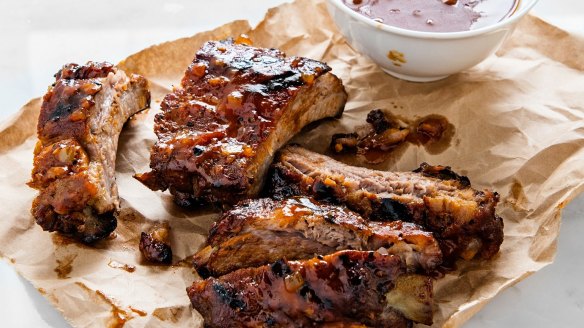
Stroll the meat display in your local butcher shop or supermarket, and the sheer variety of rib choices can be daunting. In addition to the various cuts of pork ribs, you might find large beef ribs or even racks of lamb ribs vying for attention. But pork is by far the most popular.
"When you say ribs, almost everybody thinks you're talking about pork ribs," says Meathead Goldwyn, founder of amazingribs.com and author of Meathead: The Science of Great Barbecue and Grilling. "They seem to be the holy grail." Part of the fascination with pork, Goldwyn says, is the presentation. Most Americans associate barbecue with pork ribs slathered with that incredibly rich, sweet, tomato-based Kansas City-style barbecue sauce.
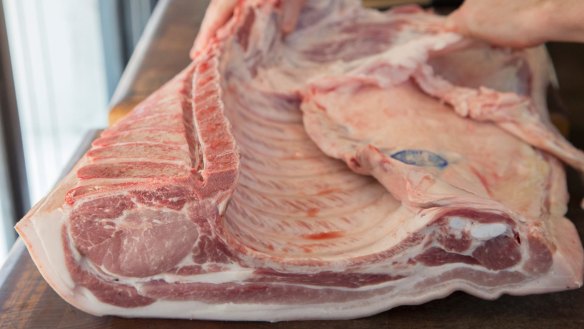
Types of ribs
All ribs, regardless of the cut, come from the rib cage of the animal. This is a tough cut of meat, coming from muscles around the bone that are used for locomotion and to hold the rib cage together. The cut known as "baby backs" come from the top of the ribs, nearest the spine, and lie just below the loin muscle. The bones are slightly curved, with most of the meat on top.
"Baby backs are beginner ribs," says Stone. "They're probably the most common because they're easy to cook." They also tend to be the most expensive because they consist of loin meat, which sits higher on the hog and tends to be leaner and initially more tender than lower cuts.
The racks generally tend to be smaller than other racks, and the amount of meat will vary depending on how the butcher cuts the rack from the loin, usually two-centimetres or so of meat. If you buy a loin roast, you'll get a slab of baby backs underneath it. For a meatier rack of baby backs, sometimes you can ask your butcher to cut the slab off the roast. "This way you've got your baby backs and a bonus pork loin roast," Goldwyn says.
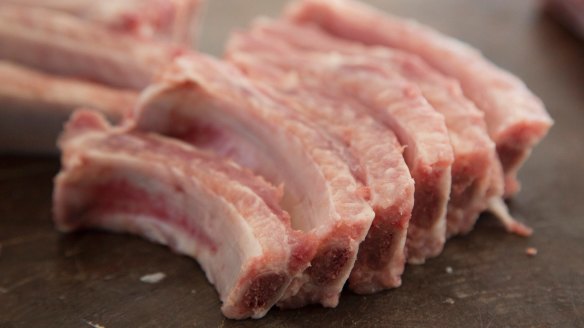
Because the meat comes from the loin, baby backs tend to cook more quickly than other ribs. They also have a tendency to dry out. As you move down the rib cage, extending around the chest to the stomach, you'll find the spare ribs. These are larger ribs, with the meat situated between the bones rather than on top, and there's a lot more marbling and connective tissue. Because of this, spare ribs take longer to cook than baby backs, but are more tender and have more flavour.
"I probably only cook spare ribs," says Sylvie Curry, a champion pitmaster on the competition barbecue circuit. In competition, she notes, people cook spare ribs (more marbling, more moisture in the meat).
Where baby backs are a clean, rectangular cut, spare ribs are oddly shaped, owing to a strip of cartilage, fat and connective tissue called "rib tips" or "brisket" (pork brisket is not the same as beef brisket) attached at one end. Along with baby backs, this is probably the most common cut of pork ribs in Southern California. Though sometimes the tips are removed to create what's called a "centre cut" or "St Louis cut." (A rack of centre-cut ribs is sometimes referred to as "mock baby backs" because of the rectangular shape of the rack.)
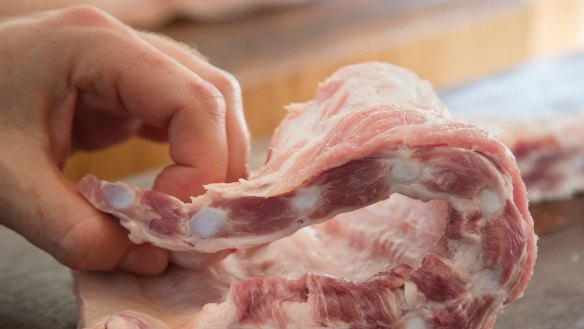
A good butcher will trim a rack of spare ribs for you, removing the rib tips – but it's also easy to do at home. If you do remove them, save the tips; they're loaded with flavour and moisture. Cook them with your centre rack, keeping in mind that the tips will be done faster given their size. Then chop them up, maybe toss them with a little sauce, and serve as an appetiser while the guests are waiting for the centre rack to finish.
(With any rack, remove the membrane on the underside of the ribs, next to the bone. As it cooks, the membrane becomes rubbery and chewy. You can ask your butcher to remove it or peel the membrane away yourself using a butter knife.)
Depending on where you are in America, you might also find other cuts labelled as ribs. One common cut is "country ribs" – not true ribs but a flavourful, fatty cut that includes meat from the shoulder or blade of the pig. Country ribs are usually sold boneless and are cut into rib-shaped pieces.
Cooking: rib science
It's important to season ribs – and while you'll see complex rubs, bastes and sauces used on competition shows, it needn't be that elaborate.
"When I'm cooking at home, sometimes I don't even want the taste of rub," says Curry. "I prefer plain old salt and pepper."
Goldwyn recommends one-half teaspoon kosher salt (or a quarter-teaspoon table salt) per 450 grams of ribs. And rather than using a store-bought rub (most contain salt and will throw off your seasoning ratio), come up with your own or look up a simple recipe that doesn't contain salt.
Let the seasoned ribs sit in the fridge for at least a few hours or up to overnight before cooking. "As the salt gets wet on the surface of the meat, it melts, causing an electrical charge," Goldwyn says. This charge causes the ions in the salt to penetrate deep into the meat, improving flavour.
Finish your ribs with a barbecue sauce, if you'd like. Store-bought sauces are fine – there are many good ones out there – but if you'd rather personalise your sauce, start by tweaking your favourite store-bought sauce to find out what flavours you like, then experiment. Just remember to sauce the ribs at the very end of cooking. If you sauce before the ribs are done, the sauce – and your ribs – will simply burn.(See Neil Perry's baby back ribs with barbecue sauce recipe – pictured below.)
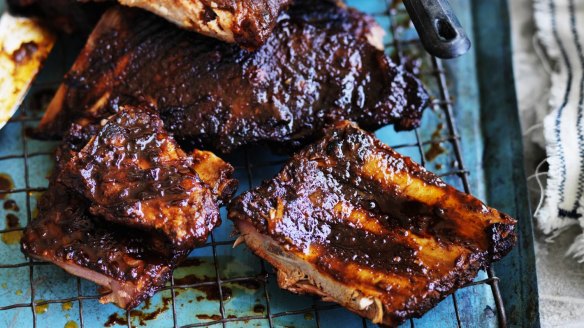
Wood flavour or smoke is a nice touch but isn't necessary. If you'd like, add a handful of wood chips (don't soak beforehand) to the coals, replenishing as needed for the first hour or so. "You can get a really nice smoke ring in just 30 minutes," says Goldwyn.
While I may use the term "cooking" when I talk ribs, there's no real difference between the terms "barbecue" or "grilling", and you can use whatever term you like. "When people say there's a difference between barbecue and grilling, they're repeating or parroting what people have told them," says Goldwyn. "It's all barbecue. Get over the snobbery."
When I cook at home, I usually start the ribs on a charcoal grill with wood chips to flavour the meat with smoke. I then tightly cover the ribs and finish them in a low oven. Curry actually prefers to cook her ribs on her gas grill when she's not competing.
One key to good ribs is a low cooking temperature. "If you cook ribs quickly or to a normal pork temperature of about 60C, they're gonna be impossible to chew," stresses Goldwyn. Over high heat, the proteins in the meat shrink and squeeze out moisture and the meat becomes dry. Cooking temperatures will range from 110C to 150 degrees or so. I like to keep the temperature right around 120C.
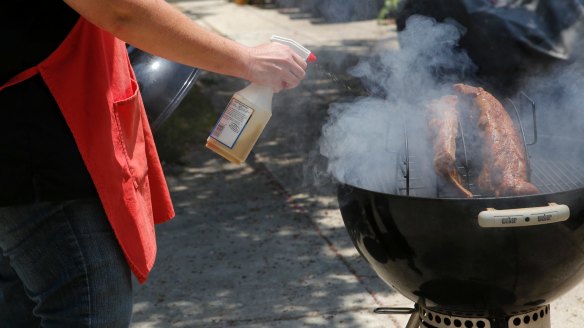
If the temperature gets too high or your ribs get too hot, baste the rack using a mop or spray bottle. Water is fine or you could use a mixture including fruit juice, mustard or vinegar. Basting lowers the temperature of the ribs so they cook more slowly, keeping the meat tender.
Another key is cooking over indirect heat. If you're working with charcoal, move the coals to one side of the grill so they're not directly under the ribs. If using gas, fire up the burners away from the ribs.
If you think about it, your grill or smoker can function just like an oven. Invest in a good grill thermometer so you can keep track of the ambient temperature of the air directly above or alongside the meat (not in the meat) so you can regulate the temperature.
Cooking time will vary depending on temperature and the type of rack. Baby backs might take anywhere from three to five hours to cook completely, and for spare or country-cut ribs allow four to six hours.
There are a few ways to test for doneness. Goldwyn recommends bending the meat: If the meat easily cracks as the rack is bent, it's probably done. Curry uses a toothpick: Push a toothpick in between the bones and if there's little to no resistance, they're ready.
One pro tip is to wrap the ribs in foil before finishing them on the grill or in the oven. Also called a Texas Crutch, tightly wrapping the ribs in foil with a little liquid after smoking helps to keep the ribs moist as they cook, and can speed up cooking time.
A quick note on boiling ribs: Please don't. While boiling ribs will shorten the cooking time and make the meat moist, the water will also leach out the flavour.
"Water is a solvent, that's why we wash our hands with it," says Goldwyn. "Water will dissolve the flavour in the meat." Boiling gives the ribs a mushy, spongy texture.
"I want my ribs to have the same texture as my steaks," says Goldwyn. "I don't mind if I have to chew them a little."
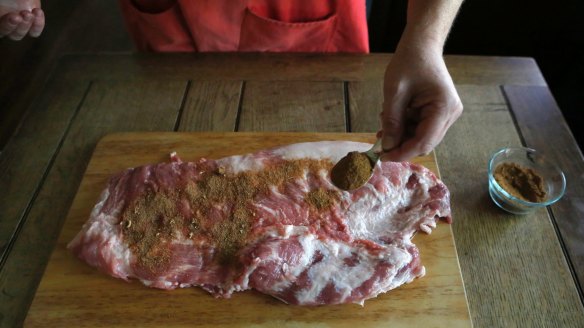
Basic rib rub
10 minutes. Makes a generous 1½cups rub.
1½ tbsp celery seeds
1½ tbsp black pepper
1½ tbsp onion powder
1½ tbsp garlic powder
1½ tbsp chilli powder
1½ tbsp dried oregano
1½ tbsp ground cumin
¼ cup sweet paprika
½ cup dark brown sugar
In a medium bowl, whisk together the celery seeds, black pepper, onion, garlic and chilli powders, oregano, cumin, paprika and brown sugar. Place the rub in an airtight container and store in a cool place away from direct sunlight. It will keep for about 2 months before the flavor starts to fade.
Note: From Noelle Carter. This rub does NOT contain salt. Before adding the rub, measure ½ teaspoon salt for each pound of ribs. Measure about 1½ tablespoons rub for each pound of ribs. Massage the salt into the rack of ribs first, then the rub.
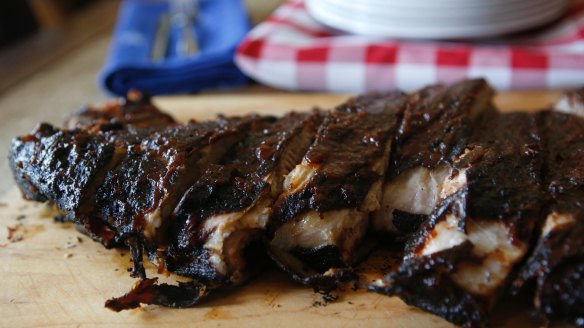
Hickory-smoked spare ribs
2 racks (2kg to 2.265kg each) spare ribs
about 4½ tsp kosher salt
about ⅔ cup basic rib rub or similar unsalted rub
hickory hardwood chips
½ cup cider vinegar
½ cup water
½ cup Dijon mustard
a generous cup Kentucky bourbon barbecue sauce (recipe below), or similar barbecue sauce
1. Prepare the ribs: Peel the membrane from the back of each rack. Rinse the ribs under cold water and pat dry with paper towels.
2. Season the ribs with salt, using ½ teaspoon kosher salt for each 450 grams of ribs. After rubbing the salt evenly over the ribs, season each rack with rub, rubbing about 3 teaspoons evenly over each rack. Refrigerate the racks until ready to smoke, up to several hours.
3. Meanwhile, prepare your smoker or grill to cook over low, indirect heat. Set up a drip pan underneath where the ribs will smoke, and fill with water. Shortly before cooking, adjust the heat as needed to maintain a temperature around 120C, and add hickory chips to start smoking. Meanwhile, prepare your baste: In a bowl, whisk together the vinegar, water and mustard.
4. Place a rib rack over the drip pan and slide the ribs onto the racks. Adjust the heat as needed (add several coals to either side of the grill as needed if using a kettle grill) to maintain the ambient temperature (about 120 degrees). Replenish the chips as needed to keep smoking. Baste the ribs every 30 minutes or so to keep it moist.
5. After about 1½ hours, baste the ribs once more. Wrap the ribs tightly in foil and continue to cook over indirect heat (about 120C) until the meat is just tender (a toothpick slid into the meat between the bones should penetrate easily, and the meat will crack as the rack is bent), 2 to 3 additional hours (time may vary depending on the size of the smoker and how well the heat is regulated). The ribs can also be finished in the oven: Place the basted ribs in a roasting pan tightly covered with foil and cook in a 250-degree oven until tender, 2 to 3 hours.
6. Uncover the racks and coat them lightly with barbecue sauce. Place the ribs directly over the coals or a hot grill and cook until the sauce is aromatic and begins to darken, about 5 minutes. Watch the ribs to make sure the sauce does not burn.
Tip: If desired, trim the meat flap ( or "skirt") and rib tips (also called pork "brisket") for a "centre cut" or "St Louis cut" rib rack. You can also have your butcher do this. Cook the flap and tips with the ribs, keeping in mind that they will cook much faster.
Time 4 to 5 hours
Serves 6 to 8
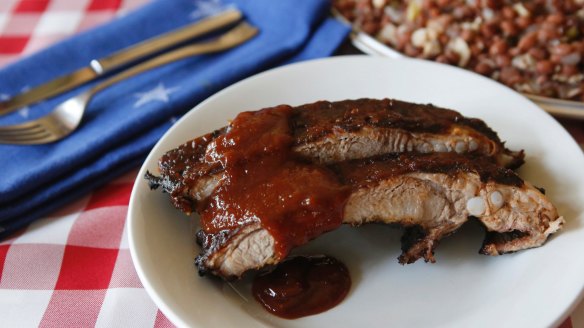
Kentucky bourbon barbecue sauce
1 large onion, thinly sliced lengthwise
6 to 8 cloves garlic, crushed
2 cups Kentucky bourbon
1 tsp ground black pepper
3 tsp chilli powder
2 tsp dried mustard
3 tsp salt, more to taste
½ cup tomato paste
4 cups ketchup
¾ cup cider vinegar
¼ cup liquid smoke
½ cup Worcestershire sauce
1 cup dark brown sugar
½ tsp Tabasco or other vinegar-based hot sauce
⅓ cup maple syrup, if desired
1. In a heavy-bottom 3- to 4-litre pot, combine the onion, garlic and bourbon. Bring the bourbon to a simmer over medium-high heat, then reduce the heat to maintain a gentle simmer and continue to cook until the onion is translucent, about 10 minutes.
2. Stir in the pepper, chilli powder, dried mustard, salt, tomato paste, ketchup, cider vinegar, liquid smoke, Worcestershire sauce, dark brown sugar, Tabasco and maple syrup, if desired, for a sweeter sauce. Continue to gently simmer for 30 minutes to give the flavours time to marry. Stir frequently, making sure to scrape the bottom of the pot to prevent burning.
3. Remove from heat and puree the sauce until fairly smooth using an immersion blender or blending in stages using a stand blender. Set aside to cool, then refrigerate, covered, in a non-reactive container for up to 2 weeks. This sauce can also be frozen.
Makes about 6 cups
Los Angeles Times
Appears in these collections
The best recipes from Australia's leading chefs straight to your inbox.
Sign up- More:
- How to